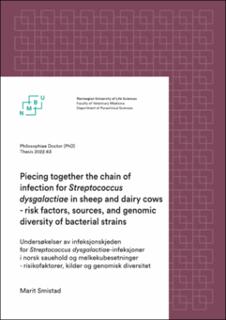| dc.contributor.advisor | Jørgensen, Hannah Joan | |
| dc.contributor.advisor | L'Abée-Lund, Trine | |
| dc.contributor.advisor | Wolff, Cecilia M. | |
| dc.contributor.advisor | Porcellato, Davide | |
| dc.contributor.advisor | Whist, Anne Cathrine | |
| dc.contributor.author | Smistad, Marit | |
| dc.date.accessioned | 2023-01-27T14:19:55Z | |
| dc.date.available | 2023-01-27T14:19:55Z | |
| dc.date.issued | 2022 | |
| dc.identifier.isbn | 978-82-575-2015-1 | |
| dc.identifier.issn | 1894-6402 | |
| dc.identifier.uri | https://hdl.handle.net/11250/3046913 | |
| dc.description.abstract | Streptococcus dysgalactiae subspecies dysgalactiae (SDSD) is an important cause of outbreaks of infectious arthritis in lambs and mastitis in dairy cows in Norway. The infections compromise animal welfare, increase antimicrobial usage and reduce production. The Norwegian sheep and dairy industries state that streptococcal infections are one of the major challenges to production.
The aim of this work was to increase our understanding of how SDSD spreads and causes disease in in sheep and cattle in Norway. We approached the aim through risk factor studies, exploration of bacterial sources, and genomic investigations of bacterial isolates from Norwegian sheep flocks and bovine dairy herds.
Several risk factors related to modern management systems were identified. Larger sheep flocks with a lambing percentage above 200 had an increased risk of outbreaks of infectious arthritis in lambs. Intramammary infections caused by SDSD were more common in bovine dairy herds housed in freestalls compared to tiestalls. Certain types of flooring were a risk factor for SDSD infections in both sheep flocks (plastic mesh flooring) and bovine dairy herds (closed flooring).
Analyses of samples collected from sheep flocks and bovine dairy herds revealed that SDSD is present in most of the visited sheep flocks and bovine dairy herds. SDSD is mainly associated with the host, but was also found in the environment. A greater proportion of environmental samples from bovine freestalls were SDSD positive compared to samples collected from sheep sheds during lambing. Wounds were particularly often colonized by SDSD in both animal species and may serve as a site of bacterial multiplication that increases the size of the bacterial reservoir. Prevention of wounds may therefore be an important measure to reduce SDSD infection pressure.
Genomic investigations revealed a clonal population structure of the SDSD, and isolates were delineated according to host species. Highly similar strains were found in epidemiologically independent flocks and herds. We found no significant association between genotype and disease severity, defined as clinical mastitis in cows (compared to subclinical mastitis) and outbreaks of infectious arthritis in lambs.
In conclusion, this study indicates that SDSD is an animal-adapted opportunist that has lived with the hosts over time. The work has contributed to our understanding of risk factors, sources, and transmission dynamics in modern management systems and also the genome and population structure of SDSD. It provides the basis for updated advice in the animal health services and will thus contribute to reducing SDSD-infections in Norwegian livestock, reducing animal suffering, and increasing productivity. | en_US |
| dc.description.abstract | Streptococcus dysgalactiae subspecies dysgalactiae (SDSD) er en viktig årsak til utbrudd av leddbetennelse hos lam og mastitt hos melkekyr i Norge. Infeksjonene fører til redusert dyrevelferd, økt forbruk av antibiotika og reduserer produksjonsutbyttet.
Målet med dette arbeidet var å øke vår forståelse av hvordan SDSD-infeksjoner spres og gir sykdom hos sau og melkeku i Norge. For å oppnå målet gjennomførte vi risikofaktorstudier, undersøkte bakteriekilder og genomiske undersøkelser av bakterieisolater fra norske saueflokker og storfebesetninger.
Flere risikofaktorer knyttet til moderne driftsformer ble identifisert. Større saueflokker med mer enn to lam per søye hadde økt risiko for utbrudd av smittsom leddbetennelse hos lam. Intramammare infeksjoner forårsaket av SDSD var mer vanlig i melkekubesetninger som ble holdt i løsdriftsfjøs sammenlignet med båsfjøs. Visse typer gulv var en risikofaktor for SDSD-infeksjoner i både saueflokker (plastrister) og melkekufjøs (tett gulv).
Analyser av prøver samlet inn fra saueflokker og melkekubesetninger viste at SDSD er til stede i de fleste besøkte besetningene. Bakterien ser ut til å trives best på verten, men synes også å overleve en stund i miljøet. En større andel av miljøprøver fra melkekufjøs var SDSD-positive sammenlignet med prøver samlet inn fra sauefjøs under lamming. Sår ble spesielt ofte kolonisert av SDSD hos begge dyrearter, og kan fungere som et oppformeringssted for bakterien. Forebygging av sår kan derfor være et viktig tiltak for å redusere infeksjonspresset.
Undersøkelser av bakteriens arvestoff viste at SDSD har en klonal populasjonsstruktur, hvor isolatene fra en vertsart var mer like innbyrdes. Svært like varianter ble funnet i epidemiologisk uavhengige flokker og besetninger. Resultatene indikerer at SDSD er en dyretilpasset opportunist som har levd med vertene over tid. Vi fant ingen signifikant sammenheng mellom genotype og sykdomsgrad, definert som klinisk mastitt hos kyr (sammenlignet med subklinisk mastitt) og utbrudd av leddbetennelse hos lam.
Arbeidet gir grunnlag for oppdaterte råd for norske saue- og melkekuprodusenter, og vil bidra til å redusere SDSD-infeksjoner i norske husdyr, bedre dyrevelferd og øke produktiviteten. | en_US |
| dc.description.sponsorship | The PhD project was part of the research project “Increasing sustainability of Norwegian food production by tackling streptococcal infections in modern livestock systems”, coordinated by the Norwegian Veterinary Institute. It received financial contributions from the Norwegian Agricultural Agreement Research Fund and the Norwegian Research council (grant numbers 280364 and 288917), Animalia, and TINE SA. | en_US |
| dc.language.iso | eng | en_US |
| dc.publisher | Norwegian University of Life Sciences, Ås | en_US |
| dc.relation.ispartofseries | PhD Thesis;2022:63 | |
| dc.rights | Attribution-NonCommercial-NoDerivatives 4.0 Internasjonal | * |
| dc.rights.uri | http://creativecommons.org/licenses/by-nc-nd/4.0/deed.no | * |
| dc.title | Piecing together the chain of infection for Streptococcus dysgalactiae in sheep and dairy cows - risk factors, sources, and genomic diversity of bacterial strains | en_US |
| dc.title.alternative | Undersøkelser av infeksjonskjeden for Streptococcus dysgalactiae-infeksjoner i norsk sauehold og melkekubesetninger : risikofaktorer, kilder og genomisk diversitet | en_US |
| dc.type | Doctoral thesis | en_US |
| dc.relation.project | Norges forskningsråd 288917 | en_US |

